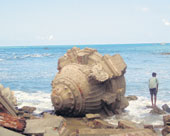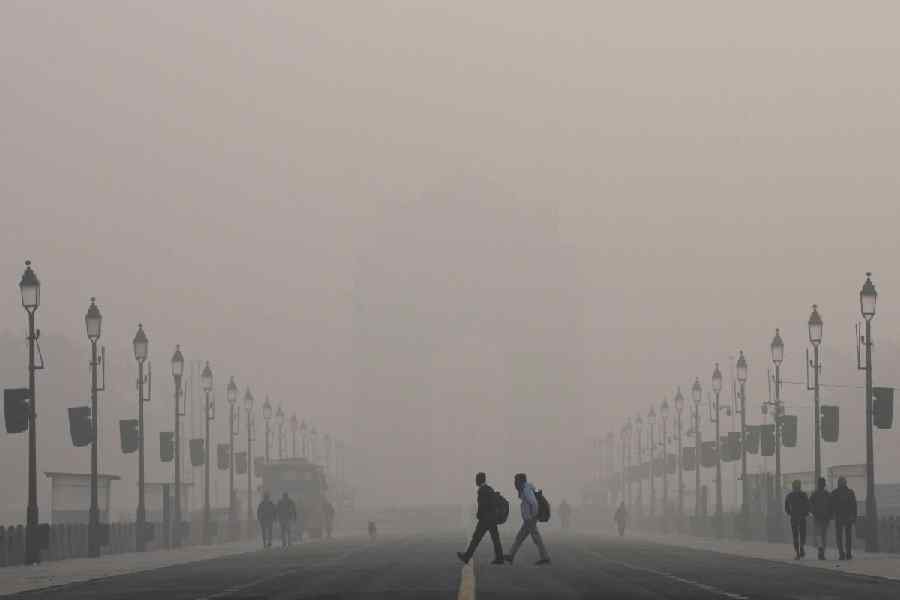 |
 |
 |
 |
| (From top): Only the waves pay homage to a part of the 13th century Pandya temple; the view from the Bungalow on the Beach hotel; the Dansborg Fort; the New Jerusalem Church |
Why do you want to go to Tranquebar?” said our hotel manager in Pondicherry, “few tourists ever visit the place ? all there is to see is an old Danish fort, a ruined Pandya temple and a deserted beach.” Nothing at all, he insisted, compared to Pondicherry’s pleasures. But his words only piqued our curiosity. So, the very next day, we hired a car and hit the road for Tranquebar, known in Tamil as Tarangabadi, the land of the singing waves.
About 135km from Pondicherry on the scenic East Coast Road, Tranquebar is the only trading post that the Danish established in India. Part of Tamil Nadu’s Nagapattinam district, Tranquebar (or Trankebar as the Danes called it) is probably better known in Denmark than it is in India. The Danes have spent a great deal of time and money restoring old churches and the fort there, in an effort to preserve their heritage.
The East Coast Road was a pleasure to drive upon, except for a few bad patches, and we made it to Tranquebar in less than three hours. It was a crisp, clear morning, the sun so bright that it hurt the eyes. Ahead was the baroque Town Gate with the Danish coat of arms displayed on the pediment. And beyond it lay the little town that, in its heyday, could easily pass off as being somewhere on the coast in Europe. We drove down the King’s Road (there’s also a Queen’s Road), lined with ancient houses and crumbling churches. Their round-headed windows, triangular gables and detailing on the porticos were distinctively different from the French-style buildings and traditional Tamil houses we’d seen in Pondicherry.
“The fort lies ahead,” said our driver. All we could see was a lone cross on a memorial facing the sea. The sun was shining relentlessly, and we decided to stop in the shade of the New Jerusalem Church built in 1718 by Tranquebar’s most famous missionary, Bartolomeus Ziegenbalg. Credited with the first Tamil translation of the New Testament in 1715, which led to a huge increase in the number of people who joined the fold, Ziegenbalg was arguably the most influential missionary of his time in South India. His grave is set into the floor in front of the altar. The church has a decorative triangular gable in which we could see a crown, the royal emblem and the date 1718. Outside the church was a cool, shady cemetery (one of three in Tranquebar), which was, its faded inscriptions revealed, the last resting place for many Danes and other Europeans.
There was something in the air, which I just couldn’t put my finger on. Was it the extreme stillness? Or the complete lack of any sign of life (other than the few piglets playing by the road, that is). Anyway, a cool breeze blew in from the direction of the sea, and we began walking rather briskly towards it. A man emerged from one of the church buildings and looked curiously at us. We explained we were tourists. “We don’t see too many tourists here,” he commented, adding, “but those who come, enjoy the fresh breeze on the beach!” It was noon, we protested, and the sun was too strong. “Wait till you reach the beach, the breeze is very cool and refreshing,” he said.
We walked beyond the church, and were rewarded by the sight of the Dansborg Fort, quite unlike any other fort one sees in India. “It looks a little like a sand castle,” Mahima commented, and she was right. Made of sand-coloured stone, the fort looked almost organic, as if it had grown out of the ground, barely a hundred metres from the seashore. Historically, the Dansborg Fort was one of Denmark’s biggest forts, second only to the more famous Kronborg in Elsinore, the inspiration for Shakespeare’s Hamlet.
The sea shone and a few boats bobbed peacefully on the horizon. The fort housed a small museum of Danish artifacts including the original treaty by which the Tanjore king, Raghunatha Nayak handed over Tranquebar to the Danish for their use as a trading outpost. The display wasn’t great. More interesting was standing on its ramparts and taking in the sea breeze.
There, we learnt a little about Tranquebar’s long and colourful history. Thanks to its strategic location on the coast, it was a centre for maritime trade long before the Danish arrived. Portuguese, Dutch and in early history, the Arabs (often referred to as the ‘yellow Moors’) all spent time in Tranquebar. When the Danes arrived to set up their trading outpost in Tranquebar in 1620, they found a cosmopolitan town with mosques, churches and temples. Soon, Tranquebar became one of Dennmark’s most important colonies, even more valuable than Greenland, their bigger and far colder colony.
Curious to chat with local people of Danish descent, we decided to walk into the nearby fishing village. But we were in for a disappointment. All the people we spoke to knew about their town’s history, but none had, or knew anyone who had, Danish ancestry. Though we read that the town still had Indian residents who knew Danish, we didn’t meet any. Instead, we saw rows upon rows of temporary shelters there, a chilling reminder of the havoc wrecked by the tsunami.
Tranquebar has had an uneasy relationship with the sea ? after all, it’s not called the Land of the Dancing Waves for nothing. Over the centuries, the sea has spilled into the town several times causing varying degrees of havoc. The Danish Fort, 100mt from the sea, had been badly damaged by the waves till it was restored in 2002. It miraculously withstood the 2004 tsunami which killed 700 people here. Although the giant wave smashed through the main door of the fort, bringing in three catamarans, the fort escaped largely unscathed. But the old Governor’s bungalow opposite the fort, now a Neemrana Hotel aptly called Bungalow on the Beach, was not as lucky. The hotel opened on Christmas Eve in 2004 after two years of extensive restoration. The next day, the tsunami crashed through the property, causing serious damage, and necessitating a further three months of restoration. We decide to stop there for lunch, not that there were any other options in the neighbourhood. The view from its shady verandahs was memorable, even though the food wasn’t.
Later, when the sun was not as strong, we walked on the beach to the seafront Pandya temple that has been in ruins since the 1940s. The temple, built in 1305, lies in a mound of rubble today. But even through the ruins, we could see how majestic this shore temple must have once looked. A couple of teenagers played in the sea as we combed the beach for shells and pebbles. All I could do was look at the waves and think about all they’d taken away that fateful December morning in 2004.
Even though heat lingered in the fading afternoon sun, the breeze was cool and very fresh. Long after we’d left Tranquebar, I learnt why ? Tranquebar’s beach has been identified as one of the two places on Earth richest in ozone (the other is in Switzerland). Ozone not only prevents the sun’s harmful ultraviolet rays from penetrating the atmosphere, it also is said to possess a rejuvenating effect on one’s health. If only I’d known this while we were walking there that day, I’d have breathed more deeply.
Back in Delhi, into the maddening grind that’s everyday life, I think of Tranquebar whenever I’m stretched too thin. I taste the spray on my face and remember the textured yellow walls of the fort against the brilliant blue sea, and for a brief moment, I relax.
Photographs by the author











